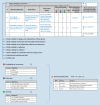Regulation (EU) 2017/746 (IVDR): practical implementation of annex I in pathology
- PMID: 38047950
- PMCID: PMC10713655
- DOI: 10.1007/s00292-023-01274-6
Regulation (EU) 2017/746 (IVDR): practical implementation of annex I in pathology
Abstract
Background: Regulation (EU) 2017/746 on in vitro diagnostic medical devices (IVDR) imposes several conditions on pathology departments that develop and use in-house in vitro diagnostic medical devices (IH-IVDs). However, not all of these conditions need to be implemented immediately after the IVDR entered into force on 26 May 2022. Based on an amending regulation of the European Parliament and the Council of the European Union, the requirements for IH-IVDs will be phased in. Conformity with the essential safety and performance requirements of annex I must be ensured from May 2022.
Objectives: With this article, we would like to present the practical implementation of the currently valid conditions for IH-IVDs at the Institute of Pathology at the University Hospital of Heidelberg, in order to provide possible assistance to other institutions.
Conclusions: In addition to the intensive work on the requirements for IH-IVDs, several guidance documents and handouts provide orientation for the implementation and harmonisation of the requirements for healthcare institutions mentioned in Article 5 (5). Exchange in academic network structures is also of great importance for the interpretation and practical implementation of the IVDR. For university and nonuniversity institutions, ensuring conformity with the IVDR represents a further challenge in terms of personnel and time, in addition to the essential tasks of patient care, teaching and research and the further development of methods for optimal and targeted diagnostics, as well as the maintenance of the constantly evolving quality management system.
Zusammenfassung: HINTERGRUND: Die Verordnung (EU) 2017/746 über In-vitro-Diagnostika (IVDR) stellt mehrere Bedingungen an Pathologische Institute, die hausinterne In-vitro-Diagnostika (IH-IVD) entwickeln und anwenden. Diese Bedingungen müssen jedoch nicht alle unmittelbar mit dem Geltungsbeginn der IVDR zum 26.05.2022 umgesetzt worden sein. Auf der Grundlage einer Änderungsverordnung des Europäischen Parlaments und des Rates der Europäischen Union werden die Anforderungen an IH-IVD stufenweise eingeführt. Die Konformität mit den grundlegenden Sicherheits- und Leistungsanforderungen gemäß Anhang I muss seit Mai 2022 gewährleistet sein.
Ziel der arbeit: Mit diesem Artikel möchten wir die praktische Umsetzung der aktuell gültigen Bedingungen für IH-IVD im Pathologischen Institut des Universitätsklinikums Heidelberg vorstellen und damit mögliche Hilfestellung für andere Einrichtungen geben.
Schlussfolgerungen: Neben der intensiven Auseinandersetzung mit den Anforderungen an IH-IVD geben mehrere Handreichungen und Hilfestellungen eine Orientierungshilfe zur Umsetzung und Harmonisierung der in Artikel 5 (5) genannten Anforderungen an Gesundheitseinrichtungen. Auch der Austausch in akademischen Netzwerkstrukturen ist für die Interpretation und die praktische Umsetzung der IVDR von großer Bedeutung. Für universitäre und nicht-universitäre Einrichtungen stellt die Sicherstellung der IVDR-Konformität – neben den wesentlichen Aufgaben in der Krankenversorgung, in der Lehre und der Forschung und Weiterentwicklung von Methoden zur optimalen und zielgerichteten Diagnostik sowie der Aufrechterhaltung des sich stetig weiterentwickelnden Qualitätsmanagementsystems – eine weitere personelle und zeitliche Herausforderung dar.
Keywords: In-house manufacturing; Laboratory-developed tests; Quality Assurance in health care; Quality Management; Regulatory requirements.
© 2023. The Author(s).
Conflict of interest statement
A.-L. Volckmar: personal fees from AstraZeneca outside the submitted work. D. Kazdal: personal fees from AstraZeneca, Bristol-Myers Squibb, Pfizer, Lilly, Agilent and Takeda outside the submitted work. A. Stenzinger: advisory board/speaker: AGCT, Aignostics, Astra Zeneca, Bayer, BMS, Eli Lilly, Illumina, Incyte, Janssen, MSD, Novartis, Pfizer, Roche, Seattle Genetics, Takeda, Thermo Fisher; grants: Bayer, BMS, Chugai, Incyte. A. Kahles, H. Goldschmid, C. Ploeger, R. Penzel, J. Budczies, C. Flechtenmacher, U.M. Gassner, M. Brüggemann, M. Vogeser and P. Schirmacher declare that they have no competing interests.
Figures







References
-
- Arbeitsgemeinschaft der Wissenschaftlichen Medizinischen Fachgesellschaften e. V. (AWMF) Handreichungen und Muster der Ad hoc Kommission In vitro Diagnostika. https://www.awmf.org/service/arbeitshilfen-und-formulare#c1797. Accessed 25.05.2023
-
- DAkkS . Leitfaden des Sektorkomitees Pathologie/Neuropathologie für die Validierung von Untersuchungsverfahren in der Immunhistologie—ID: 71 SD 4 028. 2016.
-
- DAkkS . Leitfaden des Sektorkomitees Pathologie/Neuropathologie für die Validierung von Untersuchungsverfahren in der Molekularpathologie—ID: 71 SD 4 037. 2016.
-
- DakkS Medizinische Diagnostik—Fachbereich 3.5 im Überblick. https://www.dakks.de/de/fb-3.5.html. Accessed 25.05.2023
-
- EUDAMED—European database on medical devices. https://ec.europa.eu/tools/eudamed/#/screen/home. Accessed 25.05.2023
Publication types
MeSH terms
Substances
LinkOut - more resources
Full Text Sources
